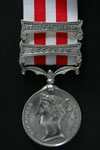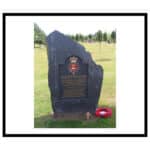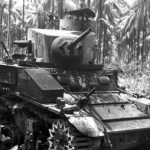India 1857-80
The Indian Mutiny 1857-59
The 7th was dispatched overseas to India in 1857 to help put down the Indian Mutiny landing at Calcutta in the November of that year. This was the first occasion on which the Regiment served in India.
They were present during the whole of the operations of the siege and capture of Lucknow, 1-21 March 1858.
Lucknow 1857-59

Cornet William George Bankes VC
It was during this period the 7th Hussars particularly distinguished itself and gained its first Victoria Cross, Cornet W.G. Bankes being the gallant recipient.
When his captain was severely wounded and incapacitated Cornet Bankes took command of the troop, placed himself at its head and three times dashed upon a body of the mutineers who were attacking the guns employed in shelling a mud fort.
He slew three of the rebels himself before he fell to the ground pierced by eleven wounds from the effects of which he died later.
Late in December of 1858, the 7th was in pursuit of Nana Sahib, one of the chiefs of the rebel leaders, near the borders of Nepal, and located the enemy near the River Raptee.
On the British approach, the mutineers fled towards the river, into which they plunged. Unaware that the stream’s bed abounded with rocks, holes, tree trunks and quicksands, the Regiment gallantly dashed in after those of the enemy who contrived to cross.
Many of the sepoys were caught in the shallower waters near the bank and mercilessly cut down. Farther out towards mid-stream some of the Hussar’s horses had bravely forced their way and soon many of their riders found themselves in a difficult and treacherous position. It was then that Major Charles Craufurd Fraser gained the Regiments second Victoria Cross.

Maj Charles Craufurd Fraser VC
Captain Stisted and three troopers of the 7th had struggled desperately towards a sandbank in the middle of the river, but their horses had been swept away and drowned. They were isolated as they could not swim and a strong current was running.
Despite a sharp musketry fire from the opposite bank, Major Fraser, himself partially disabled by wounds, plunged into the river and rescued all four after considerable difficulty.
The end of 1858 saw the back of the Mutiny broken and by 1859 peace was practically restored.
The North-West Frontier
The 7th did not leave India until 1870. They saw further service in 1863 and 1864 when the 7th Hussars were represented in two of the many “small wars” which are necessary for the protection of the Indian North-West Frontier.
Their principal enemy on each occasion was the turbulent Mohmand tribe and the action at Shubkuddar, 1864, was the first occasion “ on which British Cavalry have had an opportunity of distinguishing themselves as a body in Indian Border warfare, but the one and only charge to their credit in this class of campaign ranks high among the achievements of the mounted arm”.
It was at Shubkuddar, on the 2nd of January 1864 that Troop Sergeant Major Samuel Shawyer was awarded the Distinguished Conduct Medal.
Campaign Medal
 The Indian Mutiny Medal. The Indian Mutiny Medal was a campaign medal approved in August 1858, for the issue to officers and men of British and Indian units who served in operations in suppression of the Indian Mutiny.
The Indian Mutiny Medal. The Indian Mutiny Medal was a campaign medal approved in August 1858, for the issue to officers and men of British and Indian units who served in operations in suppression of the Indian Mutiny.


